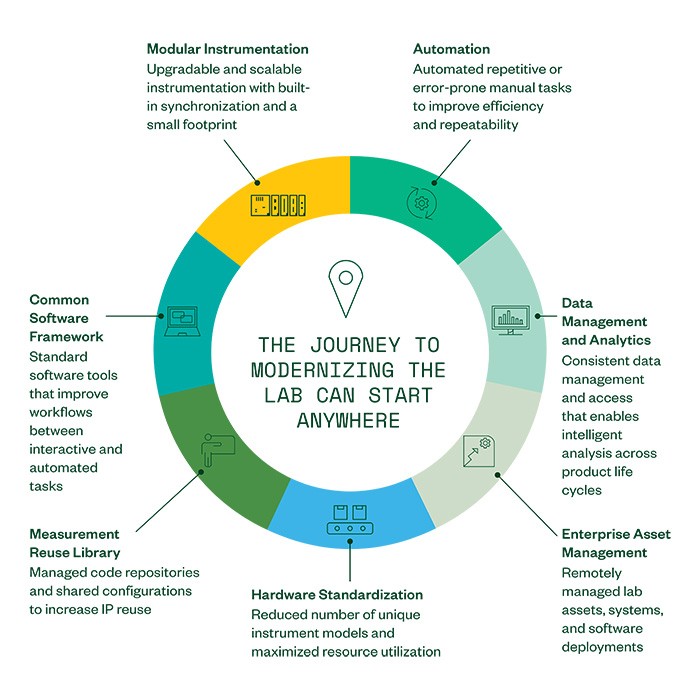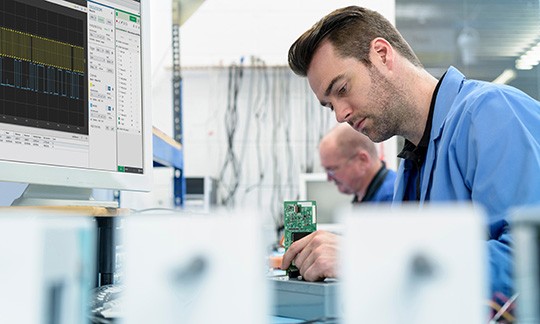
Rethinking Your Validation Lab to Speed Innovation
TREND INSIGHT
SEMICONDUCTOR | 4 MINUTE READ
Validation engineers are facing new challenges associated with increasingly complex designs and condensed time-to-market schedules. Rethinking validation lab approaches can help teams keep up with the pace of innovation.
Meet Val: Val, the validation engineer. Val enjoys her job and typically thrives under pressure, but lately she’s been overwhelmed. From the moment she clocks in for a day of test, she is met with challenging obstacles that slow her processes down. As we’ve discussed in our "Keeping Up with the Pace of Change" semiconductor eBook, increasingly complex electronics products are growing design time requirements and shortening validation windows. Yet at the same time, engineers are yearning for more time to deal with all the extensive bring-up, debug, and statistical characterization that comes with greater test coverage.
Adapting to aggressive time-to-market demands—oftentimes under resource constraints—is a lofty task, but luckily this is a challenge Val doesn’t have to conquer alone. No one said validating some of the world’s most important innovations would be easy, but Val wishes her tools were a bit more efficient and that team collaboration was more seamless. Even getting a simple measurement like power voltage in the lab can be daunting, and sometimes Val feels like there are “too many cooks in the kitchen” with everyone trying to solve the same problem from scratch. Each team in the lab creates new software when code may already exist and they even have different test processes, so data from design to simulation and validation to production is hard to compare. Some teams even write their data manually or without automation, adding to the redundancy. Val loves solving complex problems to help bring better products to the world faster, but her frustration is building as she notices missed opportunities to streamline the validation process.
History Tells All
Your validation processes and lab environment may be different from Val’s, but you’ve probably felt the growing pressures to perform more and faster for the sake of innovation as companies seek bigger market share’s—and we know that this trend won’t be slowing down any time soon.
We’ve seen this dynamic throughout history, take the automotive industry for example. We’ve gone from engines, carburetors, fuel injectors, and transmissions to batteries, chips, and computer systems. Automakers are eager to make their mark in the electric and autonomous driving era that’s quickly being ushered in and embraced by the public. New features and technologies to support these vehicles require higher volume characterization and keeping up with demand requires automating different stages of the product development process, which is easier said than done.
There’s Something for Everyone
Is there a magical solution to stay ahead of the curve, especially with industry competition and competing priorities within your organization? Not quite…but rethinking your approach to validation can help your team effectively rise to the technological challenges of today and prepare for those of tomorrow. There is no “one size fits all” approach to future-proofing your lab, and even the smallest change can lead to big results. Everyone starts in a different place—some of us need to consider automating measurements or standardizing software, while others may need to make small tweaks in other areas. Wherever you are, progress is possible. NI offers technical expertise to help you streamline engineering workflows and offers scalable hardware and software solutions that enable data automation and analytics. For instance, even simple automation reduces characterization time and produces invaluable measurement data, which in turn reduces costs and frustration for all the “Vals” of the world. Productivity generated in one place can be invested toward making your lab more efficient in other ways.

Accelerate Together
Even if you’re armed with the right tools, reimagining your lab is most effective when all departments share best practices, particularly in the product development validation phase. Cohesive strategies, standardized systems, and reusing IP helps to eliminate silos.
While each day brings something new, Val realizes now that her lab is a long-term work in progress. This week, her organization is starting to implement a common software framework to connect data during different stages of product development. Hopefully, this will help her team draw deeper product insights.
Do you know what your next step will be to revamp your lab? Learn how NI can help and explore solutions to accelerate lab validation.


